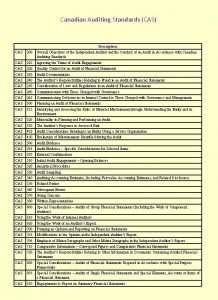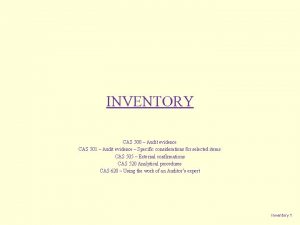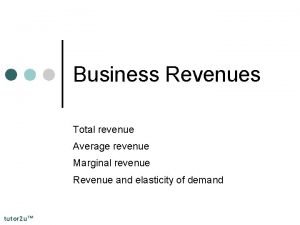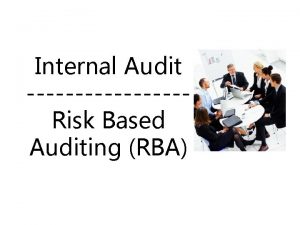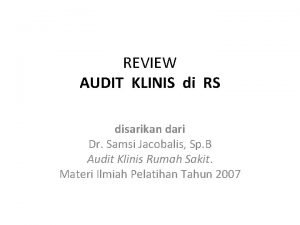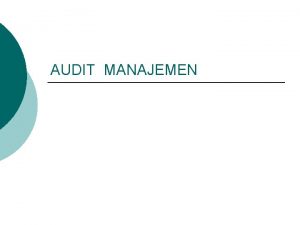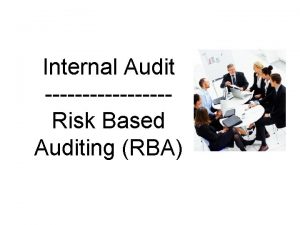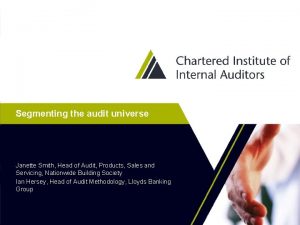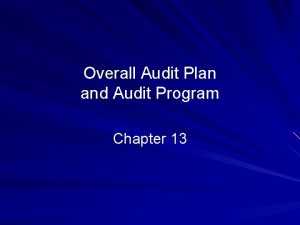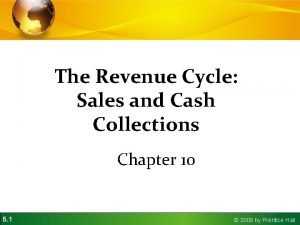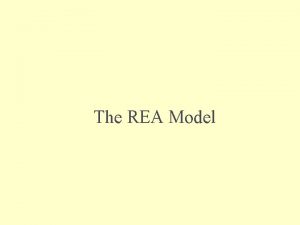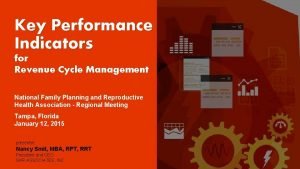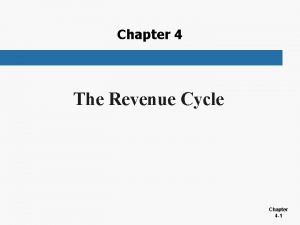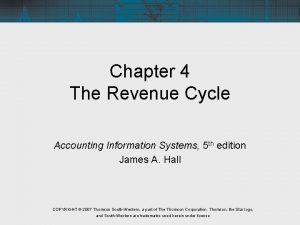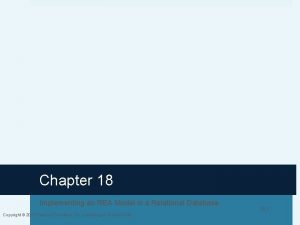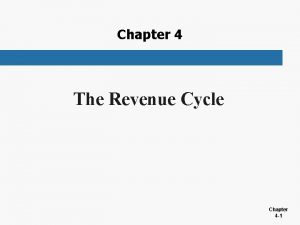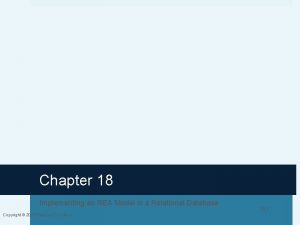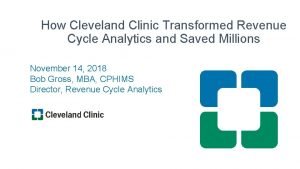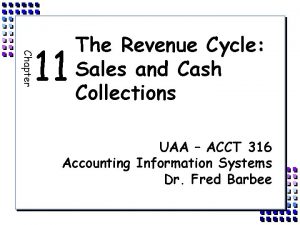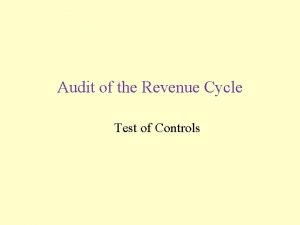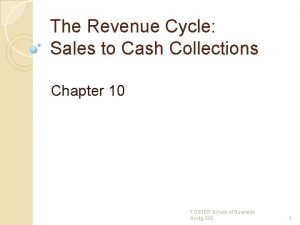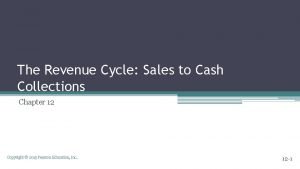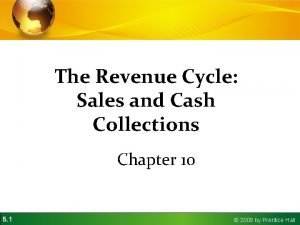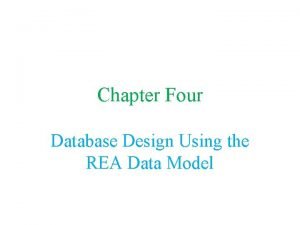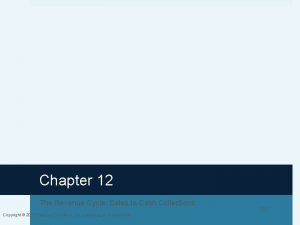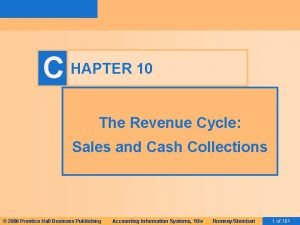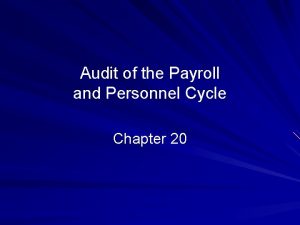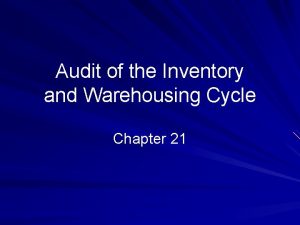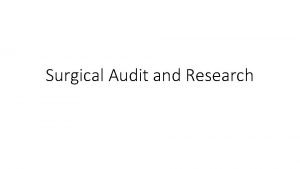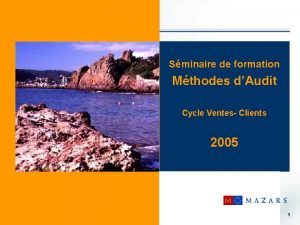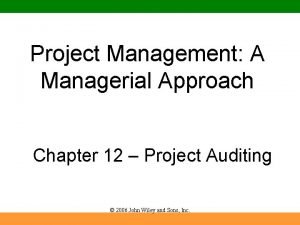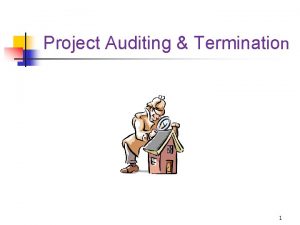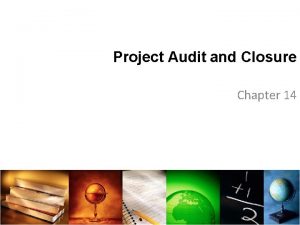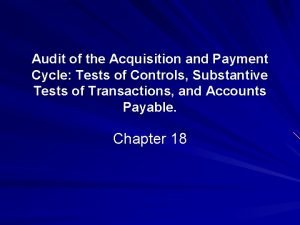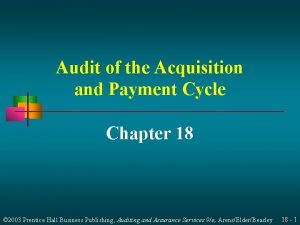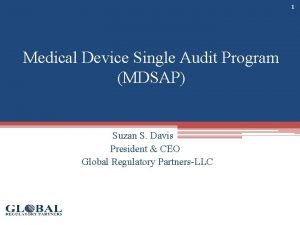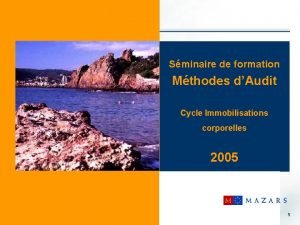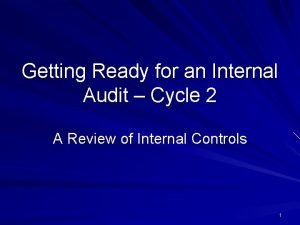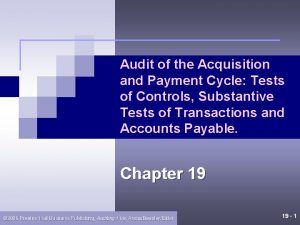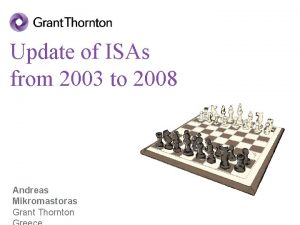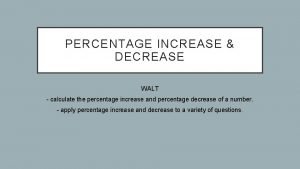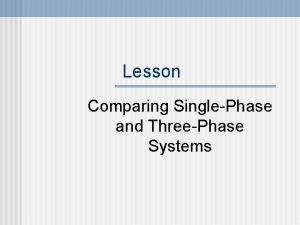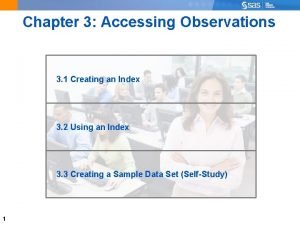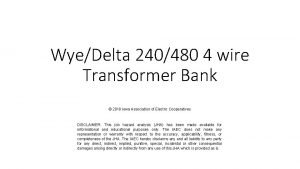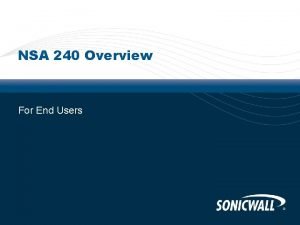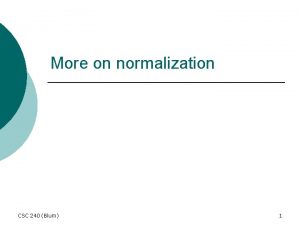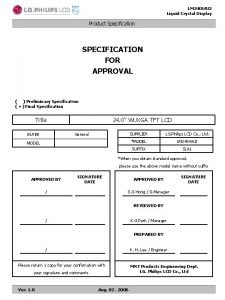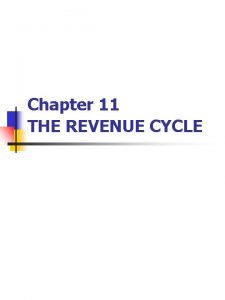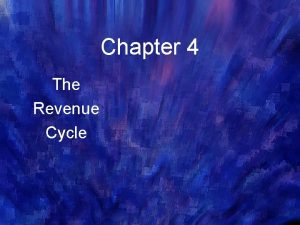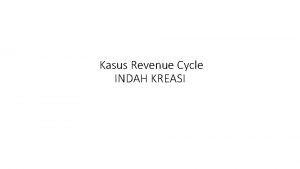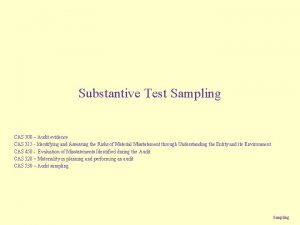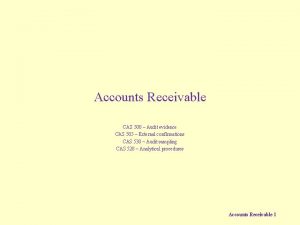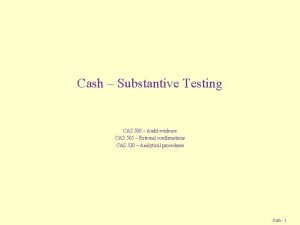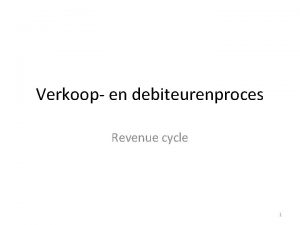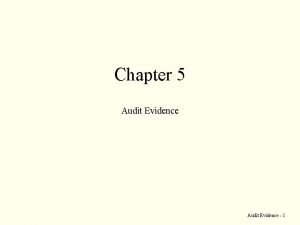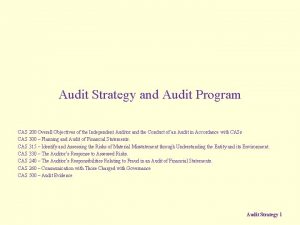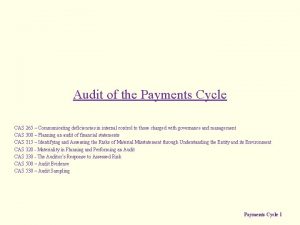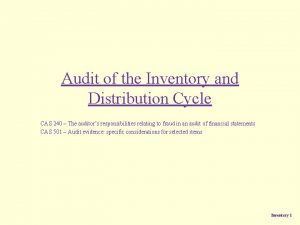Audit of the Revenue Cycle CAS 240 The































































- Slides: 63

Audit of the Revenue Cycle CAS 240 – The auditor’s responsibilities relating to fraud in an audit of financial statements Revenue Cycle 1

Typical Transactions in the Sales and Collection Cycle Five major classes of Transactions: • Sales • Cash receipts • Sales returns and allowances • The write-off of uncollectible accounts • Bad-debt expense Revenue Cycle 2

An Overview of Functions, Documents, and Accounting Systems • Order Entry Department – The starting point Customer Order Prepare Sales Order Sales order 1 2 Customer 3 Credit Department A Revenue Cycle 3

Okra Development Corp. Copy Purchase Order 6 -3378 8924 Bailey Road Salem, OR 92117 Date: Ship By: Terms: To: Faragut Sales, Inc. 3812 Briar Drive Salem, OR 92115 Quantity Number 10 Model 317 August 5, 201 X September 12, 201 X 2/10, n/30 FOB Shipping Point Ship to: Okra Development Corp. 8924 Bailey Road, Salem, OR 92117 Description Roller Bearing for Price Amount 48. 00 480. 00 Model 3118 Ripper Purchase order number must appear on all shipments and invoices Ordered By Margaret Spangler Revenue Cycle 4

64412 Sales Order To: Copy Okra Development Corp. 8924 Bailey Road Salem, OR 92117 Ship by September 12, 201 X Terms: 2/10, n/30 FOB Shipping Point Faragut Sales, Inc. Ship to Okra Development 8924 Bailey Road, OR Credit Approval C. H. Goods Counted M. K. Customer Order Number 6 -3378 Quantity Number Description 10 Model 317 Roller Bearing Amount 480. 00 Date Shipped: 8/20/0 X. Freight Bill #229 -237441 Revenue Cycle 5

• Shipping involves the Shipping Department Order Entry Approved Sales Order SO Billing and A/R BL BL Prepare Multi-Part Bill of Lading BL BL N Customer Common Carrier Revenue Cycle 6

BILL OF LADING Faragut Sales, Inc. 229 -237441 3812 Briar Drive Salem, OR 92115 Shipp to: Destination: Carrier: Copy August 20, 201 X Okra Development Corp. 8924 Bailey Road, Salem, OR 92117 Yellow Express Car Initial: Car No. Number of Description of Articles, Packages Special Marks, and Exceptions Weight Rate 5 Roller Bearings, 2 each 28 lbs. 3 Faragut Sales Shipper, Per Joe Chen Class or Agent Yellow Express Per Sue Jones Revenue Cycle 7

• Sales order & Bill of Lading goes to • Billing/Accounts Receivable Department Shipping Department SO BL INV N INV Prepare Sales Invoice & Sales Summary INV Cost Department for Perpetual Inventory Sales Summary General Accounting Customer Revenue Cycle 8

D 8 -9912 Faragut Sales, Inc Copy 3812 Briar Drive, Salem, OR 92115 Sales Invoice Sold to: Okra Development Corp. 8924 Bailey Road Salem, OR 92117 Shipped to: Freight Bill No. 8924 Bailey Road Salem, OR 92117 229 -237441 FOB Shipping Point Invoice Date Shipped Terms Your Order No. August 25, 201 X August 20, 201 X 2/10, n/30 6 -3378 Quantity We are pleased to serve you Price Amount 10 Model 317 48. 00 480. 00 Pricing and Math J. D. Account Coding S. A. L. Revenue Cycle 9

Page 327 SALES JOURNAL Date Sold to: Invoice No. Amount August 25 Okra Development Corp. D 8 -9912 480. 00 Revenue Cycle 10

• Cash Collection • Receptionist/Mail Room Clerk Customer Invoice Copy Cheque Invoice Cheque List Prepare List of Cash Received (2 copies) List Cashier Control Copy to General Accounting Revenue Cycle 11

Okra Development Corp. REMITTANCE ADVICE Salem, Or. Invoice No. D 8 -9912 Cheque No. 867 Date 8 -25 -1 X Date 9 -04 -1 X Voucher 9 -00018 Vendor No. 003270003 Gross Amount Discount 480. 00 9. 60 Vendor Name Faragut Sales, Inc. Net Amount 470. 40 Total Amount 470. 40 Revenue Cycle 12

15642 September 5, 201 X Cash Receipts Listing Fountain City Warehousex, 400. 00 Adding Machine Tape Charlotte Sawyers, Inc. x, 295. 00 Brown, Inc. 1, 200. 00 Okra Development Corp. x, 470. 40 Toil Incorporated x, 490. 00 Harreleson Hardware 1, 872. 80 Barnaby Sales, Inc. x, 982. 00 Hartfords x, x 92. 00 x, 120. 00 x, x 98. 32 x, x 23. 66 x, 842. 33 x, 988. 11 3, 130. 40 5, 802. 20 J. T. Lockett Preparer September 5, 201 X Cash Summary Cash Receipts Listing 5, 802. 20 Over-the-counter cash receipts 3, 130. 40 8, 932. 60 Revenue Cycle 13

• Cash must be deposited in the Bank • Cashier Mail Clerk List of Receipts Invoice Copies List of Receipts Cheques CR Summary Cheques Prepare Deposit Slip & Cash Receipts Summary A/R to update A/R Sub-Ledger Deposit Slip General Accounting Bank Revenue Cycle 14

First National Bank Faragut Sales, Inc. Deposit Slip September 5, 201 X Currency Cheques 3, 130. 40 400. 00 295. 00 1, 200. 00 470. 00 490. 00 1, 872. 80 982. 00 92. 00 $8, 932. 60 Teller 5 Revenue Cycle 15

Page 112 Date August 25 CASH RECEIPTS JOURNAL Customer Name Okra Development Corp. Cash 470. 40 Sales Account Receivable Discount Credit 9. 60 480. 00 Revenue Cycle 16

• The Accounts Receivable Sub-Ledger must be updated • A/R Department Cashier List of Receipts CR Summary Trial Balance Post to the Customer Account & Prepare Trial Balance D General Accounting for comparison to the G/L Revenue Cycle 17

• The Role of General Accounting A/R Dept. Sales Summary List of Receipts Post to the General Ledger CR Summary Mail Clerk Cashier Revenue Cycle 18

Typical Documents and Records • Sale is initiated with a • What documents accompany the sale? • Routine reports – include a sales journal – aged accounts receivable trial balance – Anything else? Revenue Cycle 19

The Accounts of the Sales and Collection Cycle Gross sales Cash in bank Cash Sales on Accounts receivable Beginning balance Sales on account Ending balance Cash receipts Cash discounts taken Sales returns and allowances Charge-off of uncollectible accounts Allowance for uncollectible accounts Charge off of uncollectible accounts Sales returns and allowances Beginning balance Bad debts Ending balance Bad debts Revenue Cycle 20

Methods of Recording Transactions • Manual recording • Entered in batches • Recorded one transaction at a time Revenue Cycle 21

Control Differences Between Batch and Online Systems Batch systems: • Transactions readily traced • Groups of transactions are totaled Online systems: • Transactions recorded one at a time • Document sequencing is important Revenue Cycle 22

Control Differences For Error Detection and Correction Batch systems: • one erroneous transaction Online systems: • Focus is on preventing errors • Error follow-up is required • Input edit check for valid customer data and reasonableness Revenue Cycle 23

Batch and Online Systems: Segregation of Duties Batch systems: Online systems: • Separate • In decentralized systems • Reconciliation and error followup • Use passwords to separate Revenue Cycle 24

Risk Assessment and the Sales Cycle Why do risk assessment? Risk Type Impact upon Sales and Collection Cycle Client business risk Increased client business risk could lead to greater risks of misstatement of sales. Audit risk As audit risk decreases, the level of assurance required increases, and the extent of testing required increases. Inherent risk - overall As inherent risk increases, the extent of testing required increases; inherent risks associated with the handling of cash directly affect certain audit assertions in sales (e. g. completeness). Risk of material misstatement - overall Management biases due to bonus incentives or stated earnings forecasts could increase the extent of testing. Risk of fraud - overall Poor fraud risk management could result in increased risk of fraud, with a need to increase the extent of testing. Identify significant risks Revenue recognition is considered a significant risk unless the auditor has evidence to the contrary; this means that controls over revenue recognition need to be assessed and increased testing is required of assertions that affect revenue recognition. Remember that as risk increases Revenue Cycle 25

Effect of General Controls • General controls – Are pervasive and affect multiple transaction cycles – Typical examples of general controls Revenue Cycle 26

• If general controls are good, • If general controls are poor Revenue Cycle 27

Methodology for Designing Tests of Controls for Sales Understand general controls sales Understand internal control and evaluate design effectiveness - sales By assertion: Assess planned control risk; identify and assess risks of material misstatement - sales Evaluate cost -benefit of testing controls Design tests of controls for sales to meet transactionrelated audit objectives Audit procedures Sample size Items to select Timing Revenue Cycle 28

Documentation of Internal Controls • Internal controls need to be documented • The auditor focuses on • What type of controls can these be? Revenue Cycle 29

Key Controls for Sales • Segregation of Duties • Authorization • Documents and Records Revenue Cycle 30

• Internal verification • Prenumbered documents • Monthly statements Revenue Cycle 31

• Application Controls – These are computer internal controls Revenue Cycle 32

Tests of Internal Controls • Once the key controls have been identified, the auditor can decide • Tests of internal controls will be devised for Revenue Cycle 33

Examples of Internal Control using the Occurrence Assertion • Manual Control • Key control: credit is approved before shipment takes place. – The manual control? • Possible test of control Revenue Cycle 34

Automated Batch • Occurrence assertion • Key control: Orders causing balances to exceed credit limits are printed on an exception report • Possible test of control: Revenue Cycle 35

Automated Online • Occurrence assertion • Key control: Orders causing balances to exceed credit limits are held in a separate transaction file • Possible test of control: Revenue Cycle 36

Interdependent • Occurrence Assertion • Key control: Orders causing balances to exceed the credit limit are printed on an exception report and must be approved by a credit manager • Possible test of control: Revenue Cycle 37

Manual, Automated and Interdependent Controls From the previous examples, it can be seen that: – Manual controls are controls performed entirely by people – Automated controls (batch or online) are performed only by computerized systems – Interdependent controls rely upon computer processes (automation) but a person must also be involved to fully perform the control Revenue Cycle 38

Direction of Testing Tracing Vouching Revenue Cycle 39

JOURNAL Tracing (T) Completeness Existence Vouching (V) SOURCE Revenue Cycle 40

• Tracing – Goes from the start of the transaction to the posting – Is this a test for overstatement or understatement of sales? • Vouching – Goes from the general ledger or sales journal back to the original document Revenue Cycle 41

Typical Concerns for Tests of Sales 1. Recorded sales occurred – Occurrence – Auditor is concerned with following possible misstatements • Recorded sale for which there was no shipment • Sale recorded more than once • Shipment made to non-existent customer Revenue Cycle 42

2. Existing sales transactions are recorded – Completeness assertion – Want to test for unbilled shipments – Are shipping documents complete? 3. Recorded Sales are accurately recorded – Measurement assertion Revenue Cycle 43

4. Recorded sales are properly classified • Ensure correct entry into the general ledger 5. Sales transactions are properly updated in the master file and correctly summarized • Accuracy of the master file is essential 6. Sales are recorded on the correct dates • Sales must be billed as soon as shipment takes place • Remember all the tests can be dome with the sample of sales invoices and shipping documents Revenue Cycle 44

Typical Controls and Tests for Cash Receipts Transaction-Related Audit Objective Key Internal Control General Tests of Controls Quantitative/Dual-Purpose Test of Controls Recorded cash receipts are for funds actually received by the company (occurrence) Separation of duties between handling cash and record keeping or data entry Observe separation of duties. Independent reconciliation or review of bank accounts. Observe independent reconciliation of bank account. Review the cash receipt journal, general ledger, and accounts receivable master file or trial balance for large and unusual amounts. Trace from cash receipts listing to duplicate deposit slip and bank statements Cash received is recorded in the cash receipts journal (completeness). Separation of duties between handling cash and record keeping. Use of remittance advices or a prelisting of cash. Immediate endorsement of incoming cheques. Internal verification of the recording of cash receipts. Regular monthly statements to customers. Discussion with personnel and observation. As above. Cash receipts are deposited and recorded at the amount received (accuracy). Approval of cash discounts. Regular reconciliation of bank accounts. Comparison of batch totals with duplicate deposit slips and computer summary reports. Examine remittance advices for proper approval. Review monthly bank reconciliations. Examine file of batch totals for initials of data control clerk; compare totals with summary reports. Examine remittance advices and sales invoices to determine whether discounts allowed are consistent with company policy. Cash receipts are properly classified (classification). Use of adequate chart of accounts or automatic posting to specified accounts. Review chart of accounts and computerassigned posting accounts. Examine documents supporting cash receipts for proper classification. Cash receipts are properly included in the customer master file and are correctly summarized (posting and summarization). Regular monthly statements to customers. Use of properly approved master file change forms. Comparison of customer master file or aged accounts receivable trial balance totals with general ledger balance. Observe whether statements are mailed. Foot journals, and trace postings to general ledger and accounts receivable master file. Cash receipts are recorded on correct dates (timing). Procedure requiring recording of cash receipts on a daily basis. Observe unrecorded cash at any point in time. Observe immediate endorsement of incoming cheques. Examine indication of internal verification. Observe whether monthly statements are sent to customers. Examine master file change forms for proper authorization. Examine documentation verifying that comparison was complete, Trace from remittances or prelisting to duplicate bank deposit slip and cash receipts journal. Review reconciliation reports of credit card or electronic funds transfer receipts. Compare dates of deposits with dates in the cash receipts journal. Revenue Cycle 45

Frequency of Testing of Internal Controls • Is an auditor allowed to use the results of prior testing in a current audit? • In this case, which type of controls must be tested annually? • Which type of controls could potentially be tested every three years? Revenue Cycle 46

Testing of Interdependent Controls • The interdependent control has two parts: – A function performed • It is only possible to rely upon the automated function if: • Both parts of the control must be tested to enable Revenue Cycle 47

What if Control Testing Yielded Many Errors? • The first step is to determine whether the errors or exceptions – were due to a particular circumstance – or restricted to a particular time period Revenue Cycle 48

• If the errors are systemic • If this alternative control achieves the same purpose and is functioning correctly • If no compensating control? Revenue Cycle 49

Material Error • If there is no compensating control • Want to quantify the extent of the error. Revenue Cycle 50

Results of Quantifying the Error • If it turns out that the results of the weakness could result in immaterial error • If a material error could result Revenue Cycle 51

Performing the Audit Program • The initial audit program is organized by audit assertion • In performing for maximum efficiency • The use of automated working paper software facilitates this process. Revenue Cycle 52

Computer-Assisted Audit Tests • Where there a large number of transactions • E. g. In internal controls testing, the auditor could use automated sampling routines Revenue Cycle 53

Suitability of Test Data • Batch systems: – Test data may be inappropriate • Online systems – Test data is useful Revenue Cycle 54

Suitability of Generalized Audit Software • Best suited for analytical review, tests of detail, or dualpurpose tests, for example: Revenue Cycle 55

Problem 12 -32, p. 421 Items 1 through 8 are selected questions of the type generally found in internal control questionnaires used by auditors to obtain an understanding of internal control in the revenue cycle. In using the questionnaire for a particular client, a “yes” response to a question indicates a possible internal control, whereas a “no” indicates a potential weakness. 1. Are sales invoices independently compared with customers’ orders for prices, quantities, extensions, and footings? 2. Are sales orders, invoices, and credit memoranda issued and filed in numerical sequence, and are the sequences accounted for periodically? 3. Are the selling function and cash register functions independent of cash receipts, shipping, delivery, and billing? 4. Are all COD, scrap, equipment, and cash sales accounted for in the same manner as charge sales, and is the recordkeeping independent of the collection procedure? 5. Is the collection function independent of, and does it constitute a check on, billing and recording sales? 6. Are customer master files balanced regularly to general ledger control accounts by an employee independent of billing functions? 7. Are cash receipts entered in the accounts receivable system by persons independent of the mail-opening and receipts-listing functions? 8. Are receipts deposited intact on a timely basis? REQUIRED a) For each of the items 1 through 8, state the transaction-related audit objectives being fulfilled if the control is in effect. b) For each control, list a test of control to test its effectiveness. . c) For each of the items above, identify the nature of the potential financial misstatement. d) For each of the potential misstatements in part (c), list an audit procedure to determine whether a material error exists. Revenue Cycle 56

Problem 12 -33, page 421 Your. Team. com is an online retailer of college and professional sports team memorabilia, such as hats, shirts, pennants, and other sports logo products. Consumers select the university, college, or professional team from a pull-down menu on the company’s website. For each listed item, the website provides a product description, picture, and price for all products sold online. Customers click on the product number of the items they wish to purchase. Your. Team. com has established the following internal controls for its online sales: 1. Only products shown on the website can be purchased online. Other company products not shown on the website are unavailable for online sale. 2. The online sales system is linked to the perpetual inventory system that verifies quantities on hand before processing the sale. 3. Before the sale is authorized, Your. Team. com obtains credit card authorization codes electronically from the credit card agency. 4. Online sales are rejected if the customer’s shipping address does not match the credit card’s billing address. 5. Before the sale is finalized, the online screen shows the product name, description, unit price, and total sales price for the online transaction. Customers must click on the Accept or Reject sales button to indicate approval or rejection of the online sale. 6. Once customers approve the online sale, the online sales system generates a Pending Sales file, which is an online data file that is used by warehouse personnel to process shipments. Online sales are not recorded in the sales journal until warehouse personnel enter the bill of lading number and date of shipment into the Pending Sales data file. REQUIRED: a. For each control, identify the transaction-related audit objective(s) being fulfilled if each control is in effect. b. For each control, describe potential financial misstatements that could occur if the control were not present. c. For each control, identify an important general control that would affect the quality of the control. d. For each control, list a test of control to test its effectiveness. Revenue Cycle 57

Problem 12 -38, Page 423 You were asked in February 2015 by the board of directors of your church to review its accounting procedures. As part of this review, you have prepared the following comments relating to the collections made at weekly services and recordkeeping for members’ pledges and contributions. 1. The finance committee is responsible for preparing an annual budget based on anticipated needs of the various church committees and for the annual fall “pledge campaign” during which most members make a commitment to contribute a certain amount to the church over the following year. 2. The financial records are maintained by the treasurer who has authority to sign cheques drawn on the church’s bank account. 3. The ushers take up the collection during the services each Sunday and place it uncounted in a deposit bag in the church safe. 4. The treasurer, who is retired, comes in Monday morning, counts the collection, and deposits it into the church’s bank account. Some members use predated numbered envelopes, but most do not. The treasurer enters members’ contributions into a spreadsheet for the numbered envelopes only. 5. The treasurer issues receipts to each member every January based on the spreadsheet amounts. The contributions up to 2013 had always exceeded the amounts pledged so that the value of the receipts given out was less than total contributions; the excess was recorded as “loose” or “open” collection. In 2014, the total of the receipts given out by the treasurer exceeded the total funds received by the church. 6. The church is registered as a charity un the Income Tax Act and is required to file a return each year to comply with its rules. Th chairperson of the finance committee is upset because the church has received a letter from the Canada Revenue Agency in connect with the return for 2014 because the return showed receipts given exceeded the funds actually received. The letter indicated that such differences could result in the removal of the church’s ability to issued income tax receipts. REQUIRED Identify the risks of error or fraud, identify control weaknesses, and recommend improvements in procedures for the following: a) Collections made a weekly services. b) Recordkeeping for members’ pledges and contributions. (Adapted from AICPA) Revenue Cycle 58

Problem 12 -27, page 405 The following are auditor judgments and audit sampling results for six populations. Assume large population sizes. 1 2 3 4 5 6 EPER (in percentage) 2 0 3 1 1 8 TER (in percentage) 6 3 8 5 20 15 ARACR (in percentage) 5 5 10 10 100 60 100 20 60 2 0 1 4 1 8 Actual sample size Actual number of exceptions in the sample REQUIRED a. For each population, did the auditor select a smaller sample size than is indicated by using attribute sampling tables for determining sample size? Evaluate, selecting either a larger or smaller size than those determined in the tables. b. Calculate SER and CUER for each population. c. For which of the six populations should the sample results be considered unacceptable? What options are available to the auditor? d. Why is analysis of the exceptions necessary even when the populations are considered acceptable? Not using K/P, instead will use population tables Revenue Cycle 59

EXPECTED POPULATION DEVIATION RATE (IN PERCENTAGE) TOLERABLE DEVIATION RATE (IN PERCENTAGE) 2 3 4 5 6 7 8 9 10 15 20 5 PERCENT RISK OF OVER RELIANCE (ARACR) 0. 00 149 99 74 59 49 42 36 32 29 19 14 0. 25 0. 50 0. 75 1. 00 1. 25 1. 50 1. 75 2. 00 2. 25 2. 50 2. 75 3. 00 3. 25 3. 50 3. 75 4. 00 5. 00 6. 00 7. 00 236 313 386. . . . 157 208 257 303 392. . . 117 117 156 192 227 294 390. . 93 93 124 153 181 208 234 286 361 458. . . 78 78 78 103 127 150 173 195 238 280 341 421. . . 66 66 66 88 88 88 109 129 148 167 185 221 478. . 58 58 58 77 77 95 95 112 129 146 240. . 51 51 68 68 84 84 84 100 158 266. 46 46 61 61 61 76 76 89 116 179 298 30 30 30 30 40 40 50 68 22 22 22 22 30 30 37 Revenue Cycle 60

EXPECTED POPULATION DEVIATION RATE (IN PERCENTAGE) TOLERABLE DEVIATION RATE (IN PERCENTAGE) 2 3 4 5 6 7 8 9 10 15 20 10 PERCENT RISK OF OVER RELIANCE (ARACR) 0. 00 114 76 57 45 38 32 28 25 22 15 11 0. 25 0. 50 0. 75 1. 00 1. 25 1. 50 1. 75 2. 00 2. 25 2. 50 2. 75 3. 00 3. 25 3. 50 3. 75 4. 00 4. 50 5. 00 6. 00 7. 00 8. 00 194 265 398. . . . 129 129 176 221 265 390. . . 96 96 132 166 198 262 353 471. . 77 77 77 105 132 158 209 258 306 400. . . . 64 64 64 88 88 88 110 132 153 194 235 274. . . 55 55 75 75 75 94 94 113 131 149 318. . 48 48 65 65 82 82 98 98 130 160 349. . 42 42 42 58 58 73 73 73 87 115 182 385. 38 38 38 52 52 52 65 65 78 116 199 424 25 25 25 25 34 34 45 52 60 18 18 18 18 18 25 25 25 Revenue Cycle 61

Sample size ACTUAL NUMBER OF DEVIATIONS FOUND 0 1 2 3 4 5 6 7 8 9 10 5 PERCENT RISK OF OVER RELIANCE (RIA or Beta Risk) 20 25 14. 0 11. 3 21. 7 17. 7 28. 3 23. 2 34. 4 28. 2 40. 2 33. 0 45. 6 37. 6 50. 8 42. 0 55. 9 46. 3 60. 7 50. 4 65. 4 54. 4 69. 9 58. 4 30 35 40 45 50 55 60 65 70 75 80 90 100 125 150 200 300 400 500 9. 6 8. 3 7. 3 6. 5 5. 9 5. 4 4. 9 4. 6 4. 2 4. 0 3. 7 3. 3 3. 0 2. 4 2. 0 1. 5 1. 0 0. 8 0. 6 14. 9 12. 9 11. 4 10. 2 9. 2 8. 4 7. 7 7. 1 6. 6 6. 2 5. 8 5. 2 4. 7 3. 8 3. 2 2. 4 1. 6 1. 2 1. 0 19. 6 17. 0 15. 0 13. 4 12. 1 11. 1 10. 2 9. 4 8. 8 8. 2 7. 7 6. 9 6. 2 5. 0 4. 2 3. 2 2. 1 1. 6 1. 3 23. 9 20. 7 18. 3 16. 4 14. 8 13. 5 12. 5 11. 5 10. 8 10. 1 9. 5 8. 4 7. 6 6. 1 5. 1 3. 9 2. 6 2. 0 1. 6 28. 0 24. 3 21. 5 19. 2 17. 4 15. 9 14. 7 13. 6 12. 7 11. 8 11. 1 9. 9 9. 0 7. 2 6. 0 4. 6 3. 1 2. 3 1. 9 31. 9 27. 8 24. 6 22. 0 19. 9 18. 2 16. 8 15. 5 14. 5 13. 6 12. 7 11. 4 10. 3 8. 3 6. 9 5. 2 3. 5 2. 7 2. 1 35. 8 31. 1 27. 5 24. 7 22. 4 20. 5 18. 8 17. 5 16. 3 15. 2 14. 3 12. 8 11. 5 9. 3 7. 8 5. 9 4. 0 3. 0 2. 4 39. 4 34. 4 30. 4 27. 3 24. 7 22. 6 20. 8 19. 3 18. 0 16. 9 15. 9 14. 2 12. 8 10. 3 8. 6 6. 5 4. 4 3. 3 2. 7 43. 0 37. 5 33. 3 29. 8 27. 1 24. 8 22. 8 21. 2 19. 7 18. 5 17. 4 15. 5 14. 0 11. 3 9. 5 7. 2 4. 8 3. 6 2. 9 46. 6 40. 6 36. 0 32. 4 29. 4 26. 9 24. 8 23. 0 21. 4 20. 1 18. 9 16. 9 15. 2 12. 3 10. 3 7. 8 5. 2 3. 9 3. 2 50. 0 43. 7 38. 8 34. 8 31. 6 28. 9 26. 7 24. 7 23. 1 21. 6 20. 3 18. 2 16. 4 13. 2 11. 1 8. 4 5. 6 4. 3 3. 4 Revenue Cycle 62

ACTUAL NUMBER OF DEVIATIONS FOUND Sample size 0 1 2 3 4 5 6 7 8 9 20 10. 9 18. 1 10 % Risk of Incorrect Acceptance (RIA or Beta Risk) 24. 5 30. 5 36. 1 41. 5 46. 8 51. 9 56. 8 61. 6 25 30 35 40 45 50 55 60 65 70 75 80 90 100 125 150 200 300 400 500 8. 8 7. 4 6. 4 5. 6 5. 0 4. 6 4. 2 3. 8 3. 5 3. 3 3. 1 2. 9 2. 6 2. 3 1. 9 1. 6 1. 2 0. 8 0. 6 0. 5 14. 7 12. 4 10. 7 9. 4 8. 4 7. 6 6. 9 6. 4 5. 9 5. 5 5. 1 4. 8 4. 3 3. 9 3. 1 2. 6 2. 0 1. 3 1. 0 0. 8 20. 0 16. 8 14. 5 12. 8 11. 4 10. 3 9. 4 8. 7 8. 0 7. 5 7. 0 6. 6 5. 9 5. 3 4. 3 3. 6 2. 7 1. 8 1. 4 1. 1 24. 9 21. 0 18. 2 16. 0 14. 3 12. 9 11. 8 10. 0 9. 3 8. 7 8. 2 7. 3 6. 6 5. 3 4. 4 3. 4 2. 3 1. 7 1. 4 29. 5 24. 9 21. 6 19. 0 17. 0 15. 4 14. 1 12. 9 12. 0 11. 1 10. 4 9. 8 8. 7 7. 9 6. 3 5. 3 4. 0 2. 7 2. 0 1. 6 34. 0 28. 8 24. 9 22. 0 19. 7 17. 8 16. 3 15. 0 13. 9 12. 1 11. 3 10. 1 9. 1 7. 3 6. 1 4. 6 3. 1 2. 4 1. 9 38. 4 32. 5 28. 2 24. 9 22. 3 20. 2 18. 4 16. 9 15. 7 14. 6 13. 7 12. 8 11. 5 10. 3 8. 3 7. 0 5. 3 3. 5 2. 7 2. 1 42. 6 36. 2 31. 4 27. 7 24. 8 22. 5 20. 5 18. 9 17. 5 16. 3 15. 2 14. 3 12. 8 11. 5 9. 3 7. 8 5. 9 3. 0 2. 4 46. 8 39. 7 34. 5 30. 5 27. 3 24. 7 22. 6 20. 8 19. 3 18. 0 16. 8 15. 8 14. 1 12. 7 10. 2 8. 6 6. 5 4. 3 3. 3 2. 6 50. 8 43. 2 37. 6 33. 2 29. 8 27. 0 24. 6 22. 7 21. 0 19. 6 18. 3 17. 2 15. 4 13. 9 11. 2 9. 4 7. 1 4. 7 3. 6 2. 9 10 66. 2 54. 8 46. 7 40. 6 35. 9 32. 2 29. 2 26. 7 24. 6 22. 8 21. 2 19. 8 18. 7 16. 7 15. 0 12. 1 10. 1 7. 6 5. 1 3. 9 3. 1 Revenue Cycle 63
 Revenue cycle internal controls
Revenue cycle internal controls Canadian auditing standards
Canadian auditing standards Cas audit meaning
Cas audit meaning Marginal revenue
Marginal revenue How to audit revenue
How to audit revenue Perbedaan audit konvensional dengan audit berbasis risiko
Perbedaan audit konvensional dengan audit berbasis risiko Audit klinis adalah
Audit klinis adalah Beda audit medis dan audit klinis
Beda audit medis dan audit klinis Penyelesaian audit dan tanggung jawab pasca audit
Penyelesaian audit dan tanggung jawab pasca audit Hubungan ekonomisasi efisiensi dan efektivitas
Hubungan ekonomisasi efisiensi dan efektivitas Perbedaan prosedur audit top-down dengan bottom-up
Perbedaan prosedur audit top-down dengan bottom-up Meaning of auditing
Meaning of auditing Perbedaan audit konvensional dengan audit berbasis risiko
Perbedaan audit konvensional dengan audit berbasis risiko Audit
Audit What is audit universe
What is audit universe Overall audit plan and audit program
Overall audit plan and audit program Basic revenue cycle activities
Basic revenue cycle activities Give the rea
Give the rea Revenue cycle kpis
Revenue cycle kpis Application capability model
Application capability model An advantage of real-time processing of sales is
An advantage of real-time processing of sales is Revenue cycle in accounting information system
Revenue cycle in accounting information system Rea revenue cycle
Rea revenue cycle Revenue cycle system flowchart
Revenue cycle system flowchart Chapter 9 auditing the revenue cycle
Chapter 9 auditing the revenue cycle Revenue cycle rea diagram
Revenue cycle rea diagram Revenue cycle analytics
Revenue cycle analytics Revenue transaction cycle
Revenue transaction cycle Test of controls for revenue
Test of controls for revenue The primary objective in cash collection is to:
The primary objective in cash collection is to: Revenue cycle sales to cash collections
Revenue cycle sales to cash collections Revenue cycle business activities
Revenue cycle business activities Rea diagram revenue cycle example
Rea diagram revenue cycle example Revenue cycle sales to cash collections
Revenue cycle sales to cash collections Is not a basic activity of the revenue cycle
Is not a basic activity of the revenue cycle Audit comfort cycle
Audit comfort cycle Personnel cycle
Personnel cycle Audit of capital acquisition and repayment cycle pdf
Audit of capital acquisition and repayment cycle pdf Audit of the inventory and warehousing cycle
Audit of the inventory and warehousing cycle Surgical audit examples
Surgical audit examples Audit cycle vente client
Audit cycle vente client Project audit life cycle
Project audit life cycle Process of project termination
Process of project termination Objective of project audit
Objective of project audit Acquisition and payment cycle
Acquisition and payment cycle Purchase cycle audit
Purchase cycle audit Idmrf
Idmrf Feuille maitresse audit
Feuille maitresse audit How are aging schedules used?
How are aging schedules used? Acquisition and payment cycle
Acquisition and payment cycle Yüzde 60'ı 24 olan sayı kaçtır
Yüzde 60'ı 24 olan sayı kaçtır International standard on auditing 240
International standard on auditing 240 Hksa 240
Hksa 240 Wye-delta transformer bank
Wye-delta transformer bank Percentage decrease of 500 to 240
Percentage decrease of 500 to 240 Csc 240°
Csc 240° 120/240 open delta
120/240 open delta Kin 240
Kin 240 Rcp 240 definition
Rcp 240 definition Create index in sas
Create index in sas 240/480 transformer bank
240/480 transformer bank Nsa 240
Nsa 240 Csc 240 degrees
Csc 240 degrees Lm 240
Lm 240

